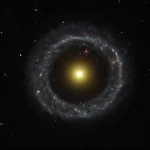Key Takeaways:
- Astronomers have identified a remarkable galaxy named Dragonfly 44, which is nearly as massive as the Milky Way but is comprised of less than 1% visible stars.
- This enigmatic galaxy has remained elusive for decades due to its extreme dimness and has now been found to consist primarily of 99.99% dark matter.
- Dark matter, a mysterious substance constituting around 27% of the observable Universe’s mass and energy, exerts gravitational force but emits no detectable light or radiation.
- The discovery reinforces the idea that dark matter is a crucial factor in maintaining the stability of galaxies and the Universe itself.
- Scientists used precise measurements of star velocities in Dragonfly 44 to calculate its mass, revealing it to be a trillion times more massive than our Sun and confirming its dark matter dominance.
Astronomers have made a groundbreaking discovery, unveiling an extraordinary ‘ghost galaxy’ known as Dragonfly 44. This galaxy, despite being comparable in mass to our Milky Way, is a cosmic enigma as it contains a mere fraction of its stars, making it appear incredibly dim. What sets Dragonfly 44 apart from other galaxies is its astonishing composition; it is primarily comprised of 99.99% dark matter.
Dark matter, which constitutes a substantial portion, approximately 27%, of the mass and energy in the observable Universe, remains a profound mystery. Although its gravitational influence is detectable, it remains entirely invisible, emitting no observable light or radiation. However, dark matter plays a vital role in maintaining the stability of galaxies and the overall structure of the Universe.
Galaxies, due to their rapid rotational speeds, would disintegrate if their gravitational force alone held them together. Scientists posit that dark matter is the missing link, providing the additional gravitational pull necessary to prevent this cosmic catastrophe. In fact, the standard model of cosmology suggests that dark matter significantly outweighs visible matter, with at least five times more dark matter for every gram of atoms in existence.
Dragonfly 44’s existence came to light in 2014 when astronomers used the WM Keck Observatory and the Gemini North Telescope to explore a region called the Coma Cluster, located some 320 million light-years away. These ‘fluffy galaxies,’ as they were described by one researcher, Pieter van Dokkum from Yale University, were found to be surviving in a dense, tumultuous region filled with dark matter and galaxies. This led scientists to propose that they are cloaked in invisible dark matter ‘shields’ protecting them from intergalactic forces.
Recent research has provided substantial evidence supporting this hypothesis. By meticulously measuring the velocities of stars within Dragonfly 44 over six nights, scientists were able to calculate the galaxy’s total mass. The stars within Dragonfly 44 were found to be moving at approximately 47 kilometers per second, indicating a mass far exceeding what could be accounted for by its visible stars alone.
This finding suggests that for Dragonfly 44 to maintain its integrity, it must consist of a staggering 99.99% dark matter, officially making it the darkest known galaxy in the Universe. While a similarly dark galaxy was discovered earlier in the Virgo cluster, Dragonfly 44 surpasses it with its higher dark matter composition.
This discovery, while fascinating, raises more questions than answers. Currently, no candidate for dark matter has provided sufficient evidence to elucidate its composition. Moreover, the mystery of how a galaxy as massive as Dragonfly 44 formed and retained its size with so little visible matter remains unsolved. Nevertheless, Dragonfly 44 offers scientists a unique opportunity to study an entire galaxy dominated by dark matter, challenging our understanding of galaxy formation and the Universe’s underlying structure.


